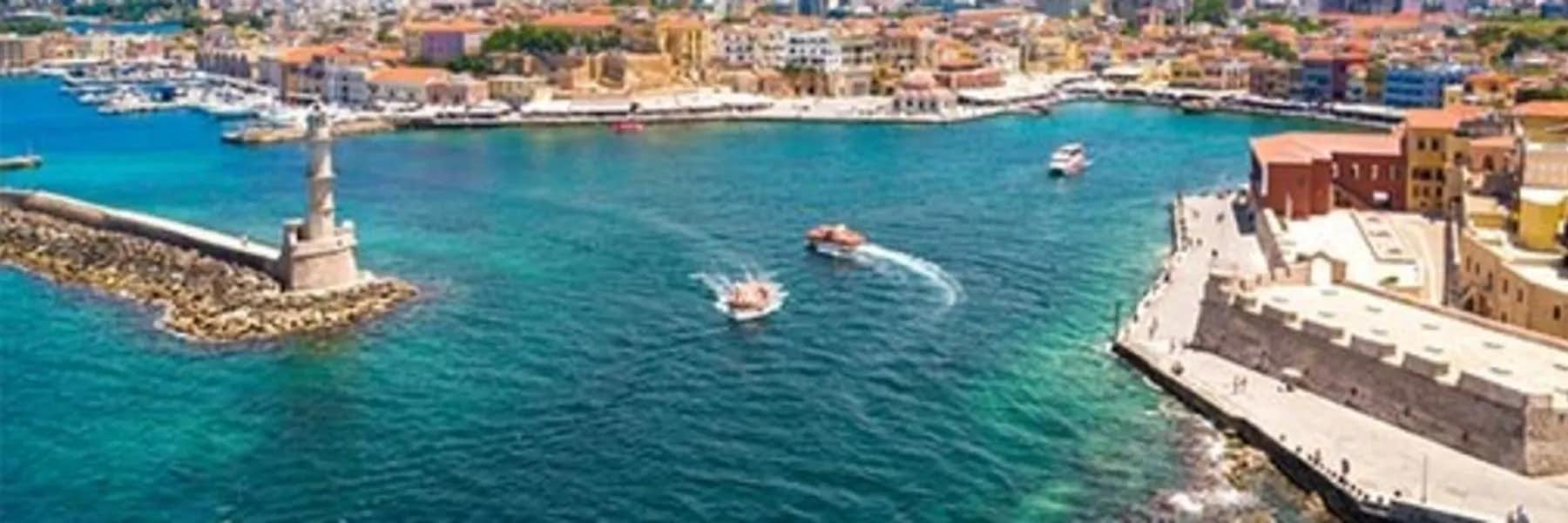The island of Crete is one of Greece’s major highlights. It’s the biggest of all the Greek islands and one of the most fascinating, whether you’re inspired by nature, history, Greek food, or the beach-focused Mediterranean lifestyle. While exploring the charms of Crete, most visitors base themselves in one of three small cities along Crete’s northern coast: Chania, Rethymno, or Heraklion.
Chania (sometimes spelled Hania or Xania) is the perfect place to start your Crete explorations. Its 14th century Venetian Harbor, complete with ancient lighthouse and waterfront restaurants, is one of the most stroll-worthy seaside spots in Europe on a sunny day, with crystal-clear waters lapping at the base of the promenade and a variety of museums, squares and Venetian/Ottoman/Egyptian-inspired architecture to investigate along the way.
With a population of 160,000, Chania is an attractive mix of narrow, cobblestoned alleys, jasmine-scented gardens, traditional leather craft shops, and inviting cafes framed with flowering bougainvillea. Because Crete has its own distinctive culture, you’ll find Chania a refreshing, low-key alternative to some of the more frenetic tourist hotspots in the Greek islands. Here, the pace is slow, the seafood is fresh, and the proud locals always have a smile ready.
Where is Chania?
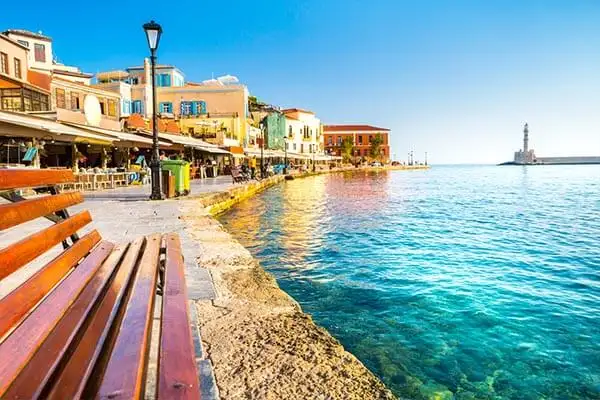
Chania lies along the northwest coast of Crete. Crete is 160 miles long and 35 miles wide at its thickest section, and the western side is arguably considered the more scenic half of the island. Visiting Chania is a study in contrasts: you can be snorkeling in the sea, stick your head above the water and see Crete’s snow-capped White Mountains in the distance.
Getting to Chania is straightforward. There are regular year-round flights from Athens and Thessaloniki—the Athens trip takes 45 minutes. Many other European cities offer seasonal flights to Chania over the busy summer months as well—Chania is the sixth busiest airport in Greece.
Ferries from the Athens port of Piraeus make the passage to and from Chania almost every day, with both daytime and overnight journeys during the warmer season. Expect the trip to take six to nine hours (depending on the ferry company you go with) and to cost around $45. It’s worth noting that there aren’t any direct ferry connections between the port of Chania and other Greek islands, however.
Chania’s location is ideal for organizing day trips to other parts of Crete, using either a rental car or small-group tour operator to take in the sights. Chania’s well-run bus system offers a cheap, efficient way to get around the city and beyond. Check the central bus station for timetables to more distant spots around the island. The bus trip from Chania to Heraklion, for example, takes two-and-a-half hours and costs a mere $17.
Why Should You Visit Chania?
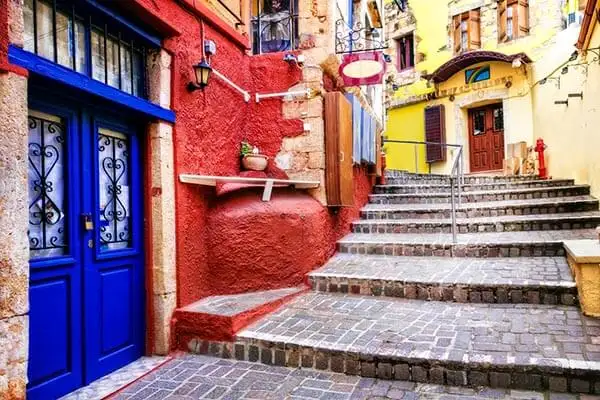
Chania is truly a breathtaking part of Greece, renowned for its history, mountains, beaches, people, food, and weather.
Settlement in the Chania region dates back to the Neolithic era, with subsequent occupation by Minoans, Dorians, Byzantines, Venetians, and Ottomans over the centuries. This long, dramatic history has left an impressive architectural mix throughout the city, with a delightful blend of ancient and modern on display wherever you look.
Chania’s beaches are some of the finest in Greece. The pink shells, golden sands, and transparent waters of Elafonisi are perhaps the most famous, but there are dozens of other beaches on this side of the island that will have you gazing in wonder. Some can only be reached by boat: Glyka Nera is a spectacular example, just a five to 10 minute ferry ride from Loutro or Sfakia. It features towering cliffs, turquoise waters, and fresh water flowing from the mountains into the sea.
Western Crete abounds with accommodation options, from chic harborside hotels and family-run mountain inns to old-town Airbnbs and units overlooking stunning beaches. Prices depend on seasonal availability but are typically quite affordable, especially for longer stays.
With the Aegean Sea at its doorstep, Chania serves up a delectable variety of fresh seafood: sardines, anchovies, whitebait, grilled octopus, and much more. Achilleas, a restaurant just west of the Venetian harbor, has a well-deserved reputation for quality regional seafood.
Chania boasts an inviting Mediterranean climate. In August, you’ll enjoy 12 hours of sunshine per day, temperatures averaging 77 F, and seawater that’s just as warm. January is the coldest (and wettest) month, averaging 52 F.
Embracing the outdoor lifestyle is easy here: the scenery, attractions, and climate all come together to create an environment that invites adventure and promotes healthy activity.
Things to do in Chania
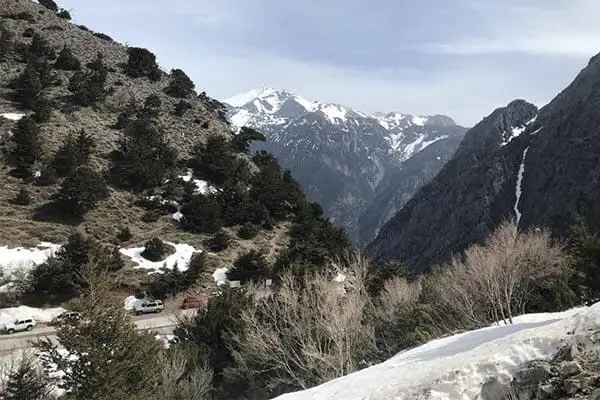
Chania has loads to see and do. Just wandering around on foot is a treat: a walk past the beachfront cafes and out to the Egyptian lighthouse is a wonderful introduction to the city, providing superb views of the main harbor.
At the Old Chania Market, you’ll find shrink-packed olives, goat-milk soap, freshly caught fish, local cheeses, meats, crafts, and much more. It’s a fine place to spend a summer evening and a great choice for cheap eats with the locals.
Just west of the port, you’ll find Kalo Chori, a marina and beach area that’s perfect for walks and picnics. The Public Garden is also worth a visit, with a café-in-a-mansion and a few white peacocks wandering the grounds.
There are more than a dozen museums in Chania. The Archeological Museum is filled with incredible pottery, jewelry, mosaics, and sculptures dating back thousands of years. The Maritime Museum of Crete houses everything from shipbuilding and wartime nautical exhibits to seashell collections and models of ancient Cretan boats. There is also the Greek National Football Museum and other museums dedicated to folklore, typography, glassblowing, and post-Byzantine art.
If you’re looking for a nice beach close to town, try Chrissi Akti (Golden Shore) or Agios Apostolos, about a 10-minute drive west of Chania. Half the fun of getting to beaches in Crete is the epic scenery along the way.
One of western Crete’s most famous attractions is Samaria Gorge. Visiting it is an all-day affair, combining a bus ride to the gorge entrance, a short boat trip along the southern coast and a lift back from the gorge’s southern end. If you want a quicker look at this natural wonder, drive from Chania to Sfakia on Crete’s southern coast, then get the ferry to Loutro and check out the gorge’s terminus from there.
Therisos Gorge is another mountain spectacle near Chania; be sure to stop at a traditional restaurant on the way to sample lamb, goat, and pork dishes cooked over open fires.
If you’re in a rental car, several beautiful sights near Chania are worth a look, including the quaint, peaceful village of Vrysses, the Venetian Fortress of Frangokastello (right next to a pretty beach), and the Agia Triada Monastery, located in secluded and breathtaking surroundings. If you’re looking for the biggest beach resort in western Crete, head to Platanias, about seven miles west of Chania.
When the weather heats up, Chania’s restaurant and nightlife scene really kicks into gear. To avoid the tourist traps, head to some of the local haunts like Boheme, Safe as Milk, or 2Lux Café.
Cretan food is healthy, delicious, and packed with fresh, seasonal ingredients. Sheep’s cheeses, aromatic herbs, virgin olive oil, local honey, and fennel feature prominently in the culinary specialties of the region. You don’t need to spend a lot to eat well in Chania: a simple Greek salad enjoyed at a seaside café, a meat-rich lunch special at a local tavern,or a quick trip to your local bakery will keep both your stomach and wallet happy. Alternatively, shop for produce at the Municipal Market and cook a hearty meal for yourself, for a pittance. Trivia alert: Cretans eat the largest quantities of fruit and vegetables in the Western world.
Must-try dishes in Chania include dakos (Crete’s version of bruschetta, topped with fresh cheese, herbs, chopped tomato, and olive oil), sarikopitakia and kalitsounia (two delicious varieties of cheese pie), and chochlioi boubouristi (fried snails in olive oil and wine). Traditional Greek fare such as souvlaki, gyros, and moussaka is affordable and easy to find all over town. Wash your meal down with a shot of pomegranate-flavored raki (Crete’s answer to ouzo) for the ultimate low-cost dining experience.
Is Chania Safe?
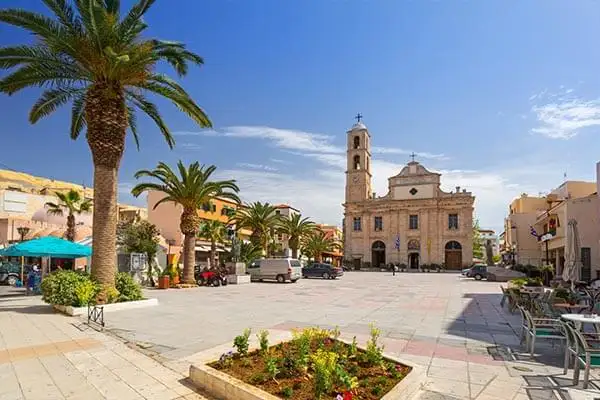
Greece is one of the safest countries to visit in Europe, and Chania is a relaxed place where you’ll feel totally secure walking home from a restaurant at midnight. The biggest nocturnal danger here is probably poorly maintained footpaths in less-visited areas, so carry a small torch at night to help navigate cobblestones and curb edges. Also, be alert for bicycles and scooters zipping around blind corners on those skinny, winding streets Chania is so famous for.
Keep personal belongings safe with common-sense precautions: men should slide wallets into the front pocket of trousers (not the back), and women should keep a close eye on purses hanging off the backs of chairs in restaurants. But overall, don’t worry— exploring Chania and Crete is a very safe and carefree experience.
Related Articles
Crete and Corfu: For a Healthy, Simple, Greek Island Retirement
Meteora, Greece: Marvelous Monasteries and Otherworldly Geology
